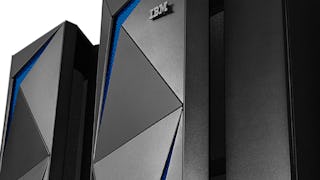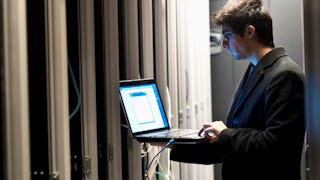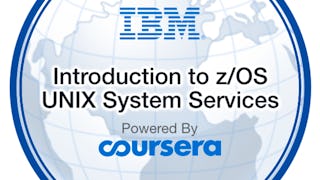This course presents the structure and control blocks of the z/OS BCP and system services. It prepares the new z/OS system programmer to identify potential bottlenecks and performance problems, perform initial error symptom gathering, and identify opportunities and requirements for tailoring an z/OS system. This course also provides prerequisite information needed for further training in specialized areas such as system measurement and tuning and system problem determination.
通过 Coursera Plus 解锁访问 10,000 多门课程。开始 7 天免费试用。


了解顶级公司的员工如何掌握热门技能

该课程共有7个模块
This unit sets the stage for the remainder of the course. The major functions of a z/OS system are reviewed, with emphasis on the relationships between components. The use of control blocks in an z/OS system is introduced, and basic IBM z System instruction execution and interrupt handling are described.
涵盖的内容
4个视频1篇阅读材料1个作业
This unit presents what occurs during the initialization of the base control program of z/OS. It also discusses what control the system programmer has over customization of the Initial Program Load (IPL) process and what control the operator has over the IPL process.
涵盖的内容
5个视频1篇阅读材料1个作业
z/OS BCP provides task management and supervisor services in order to enable the sharing of system resources and maximize the work that is processed in a given time. A solid understanding of these services is necessary to perform many system programmer activities. Examples include identifying bottlenecks, and determining status when a wait state or failure occurs.
涵盖的内容
4个视频1篇阅读材料1个作业
z/OS and IBM z System provide the architectural foundation that allows greater flexibility and more design options in the development of application programs with needs that extend beyond the boundaries of a single address space.This unit examines the hardware and software facilities that enable a program to interact with other programs executing in other address spaces and use data in data spaces.
涵盖的内容
4个视频1篇阅读材料1个作业
One of the primary functions of any computing system is the processing of data. Much of the data that is processed exists external to processor storage; that is, it might be out on a tape or DASD volume or it might be entered from a terminal. The handling of data requires the services of both software and hardware (channel subsystem and the devices attached to it).Understanding the roles of software and hardware in handling I/O requests is necessary for determining how to configure the hardware, how to tune the I/O configuration, and in analyzing I/O-related problems.
涵盖的内容
10个视频1个作业
One of the major resources available to the users of an z/OS system is storage. Programs executing in the system, whether user applications or z/OS system routines, are vying for storage. Each of the areas of storage, however, is a limited resource, and use and availability must be managed to maintain program integrity. This managing of storage in z/OS is handled by three storage managers, virtual, real, and auxiliary. In this unit, we will gain an understanding to how each of the areas of storage is assigned, used, and managed is necessary for determining how much storage is required for your installation. This is also required for tuning your system to make the most efficient use of storage, and for analyzing storage-related failures.
涵盖的内容
18个视频1篇阅读材料1个作业
The resolution of errors often requires the analysis of information produced at the time of the failure. The responsibility of the recovery termination manager (RTM) is to gather the failure indications, interface with system and application error recovery routines, and to generate the failure documentation. Understanding the function of the recovery termination manager and recovery routines is helpful for analyzing the failure documentation and for determining how to tune the system for the control of the documentation produced.
涵盖的内容
5个视频2个作业
位教师

提供方
从 Data Management 浏览更多内容
 状态:免费试用
状态:免费试用 状态:预览
状态:预览
人们为什么选择 Coursera 来帮助自己实现职业发展




常见问题
To access the course materials, assignments and to earn a Certificate, you will need to purchase the Certificate experience when you enroll in a course. You can try a Free Trial instead, or apply for Financial Aid. The course may offer 'Full Course, No Certificate' instead. This option lets you see all course materials, submit required assessments, and get a final grade. This also means that you will not be able to purchase a Certificate experience.
When you purchase a Certificate you get access to all course materials, including graded assignments. Upon completing the course, your electronic Certificate will be added to your Accomplishments page - from there, you can print your Certificate or add it to your LinkedIn profile.
Yes. In select learning programs, you can apply for financial aid or a scholarship if you can’t afford the enrollment fee. If fin aid or scholarship is available for your learning program selection, you’ll find a link to apply on the description page.
更多问题
提供助学金,






